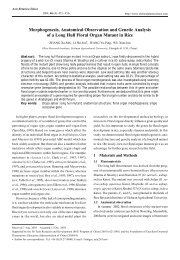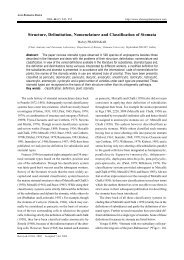Abiotic and biotic stresses and changes in the lignin ... - ResearchGate
Abiotic and biotic stresses and changes in the lignin ... - ResearchGate
Abiotic and biotic stresses and changes in the lignin ... - ResearchGate
Create successful ePaper yourself
Turn your PDF publications into a flip-book with our unique Google optimized e-Paper software.
13<br />
274<br />
275<br />
276<br />
277<br />
278<br />
279<br />
280<br />
281<br />
282<br />
283<br />
284<br />
greater accumulation of lign<strong>in</strong> <strong>in</strong> <strong>the</strong> cell walls of <strong>the</strong> parenchyma of tracheid elements<br />
<strong>and</strong> <strong>in</strong> <strong>the</strong> <strong>in</strong>tercellular space, <strong>in</strong> addition to <strong>the</strong> formation of a layer of lign<strong>in</strong>-likematerial<br />
on <strong>the</strong> surface of <strong>the</strong> callus. The ChS2 l<strong>in</strong>eage was also more resistant to UV-<br />
B, suggest<strong>in</strong>g <strong>the</strong> <strong>in</strong>volvement of lign<strong>in</strong> <strong>in</strong> cell protection aga<strong>in</strong>st this type of stress.<br />
Cotyledons of Chenopodium qu<strong>in</strong>oa exposed to UV-B radiation exhibited <strong>in</strong>creased<br />
epidermal cell wall thickness; this was associated with a large accumulation of lign<strong>in</strong><br />
due to <strong>in</strong>creased peroxidase activity (Hilal et al., 2004). Additionally, <strong>changes</strong> <strong>in</strong> <strong>the</strong><br />
ultrastructure of chloroplasts rendered <strong>the</strong>m similar to <strong>the</strong> chloroplasts of shaded plants.<br />
It was suggested that such alterations <strong>in</strong> <strong>the</strong> chloroplast were caused by reduced light<br />
penetration <strong>in</strong> <strong>the</strong> cells of <strong>the</strong> mesophyll, due to <strong>the</strong> protective effect of lign<strong>in</strong><br />
deposition. Therefore, lign<strong>in</strong> <strong>in</strong> epidermal tissue may attenuate radiation.<br />
285<br />
286<br />
287<br />
288<br />
289<br />
290<br />
291<br />
292<br />
293<br />
294<br />
295<br />
296<br />
297<br />
298<br />
Mechanical <strong>in</strong>juries<br />
Injuries <strong>in</strong>duce specific reactions <strong>in</strong> <strong>the</strong> wood which can be restricted to <strong>the</strong> bark<br />
or might extend to <strong>the</strong> cambium <strong>and</strong> xylem (Frankenste<strong>in</strong> et al., 2006). Several studies,<br />
if not most of <strong>the</strong>m, have focused on characteriz<strong>in</strong>g histological <strong>and</strong> anatomical wood<br />
<strong>changes</strong> produced by a particular type of <strong>in</strong>jury, <strong>and</strong> <strong>the</strong> obta<strong>in</strong>ed <strong>in</strong>formation is <strong>the</strong>n<br />
used to expla<strong>in</strong> <strong>the</strong> roles of <strong>the</strong>se <strong>changes</strong> <strong>in</strong> adaptation <strong>and</strong> resistance to stress. In<br />
general, attention has been paid to <strong>the</strong> <strong>changes</strong> occurr<strong>in</strong>g after <strong>in</strong>sect attack or after<br />
microorganism <strong>in</strong>fection. Some species have defence mechanisms that range from<br />
physical barriers <strong>in</strong>clud<strong>in</strong>g cuticle formation, lignification, sp<strong>in</strong>es <strong>and</strong> trichomes to <strong>the</strong><br />
biosyn<strong>the</strong>sis of toxic compounds such as alkaloids <strong>and</strong> tann<strong>in</strong>s (Delessert et al., 2004).<br />
Electron microscopy has demonstrated that <strong>in</strong>juries to <strong>the</strong> stem of Populus spp.<br />
<strong>in</strong>duce <strong>the</strong> thicken<strong>in</strong>g of <strong>the</strong> xylem fibre cell wall <strong>in</strong> three ways: syn<strong>the</strong>sis of an<br />
additional S2 layer, thicken<strong>in</strong>g of <strong>the</strong> exist<strong>in</strong>g cell wall or syn<strong>the</strong>sis of a sclereid-like







